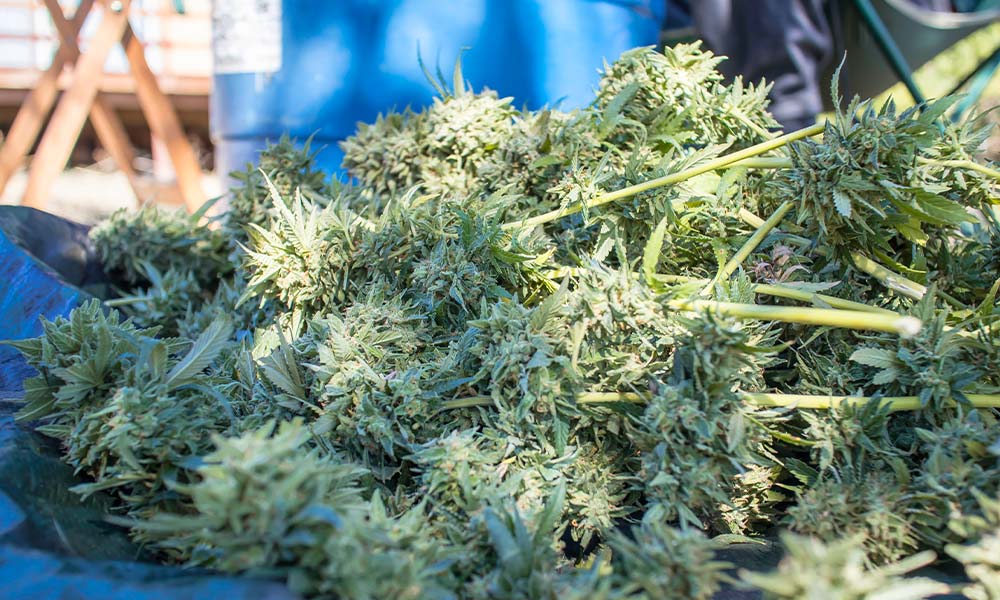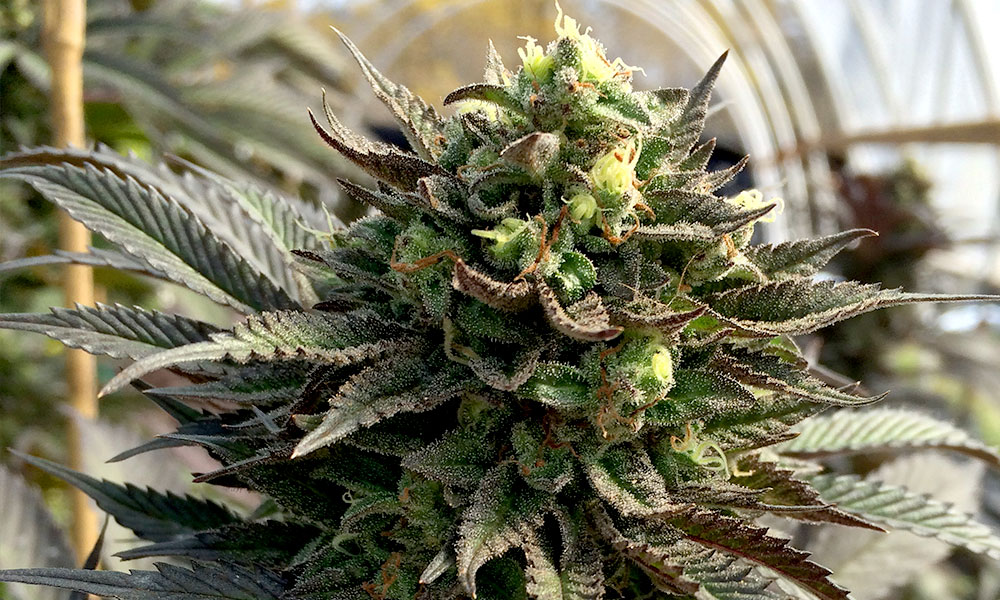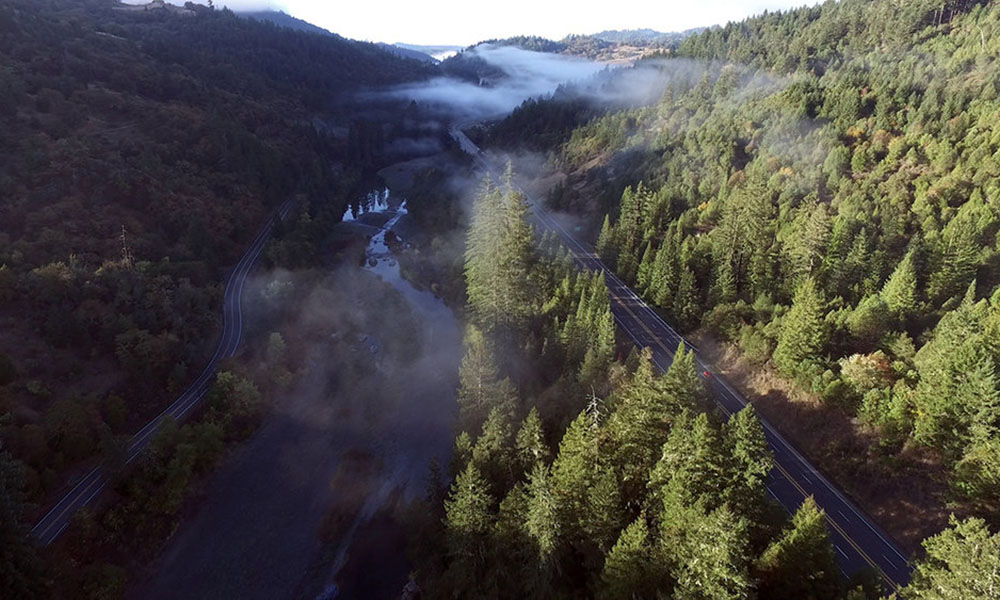
Cannabis
California’s Persisting Cannabis Dystopia: Part 1
There’s grim news from California, where cannabis industry profits are dropping, robberies of dispensaries are soaring, and police raids on unlicensed growers continue in the Emerald Triangle. Can the seeming slip back into pre-legalization dystopia be arrested?
California’s immediate post-legalization cannabis boom has now gone bust, with small growers hit the hardest. And those who remain in the illicit sector to avoid a perceived bureaucratic burden face continued police repression. In other words, it’s the worst of both worlds.
Is the Industry Facing Extinction?
In an all too symbolic development, the Garcia Hand Picked brand, launched by the family of late Grateful Dead guitarist Jerry Garcia in 2020, closed operations in California at the start of this year.
One recent report estimated the California cannabis industry’s collective debt at over $600 million. Meanwhile, a new state code shifts the burden for paying cannabis excise taxes from distributors to retailers—the most vulnerable sector, and obviously a critical one. Media reports hype an imminent “extinction event” for the cannabis biz in the state that pioneered that industry in the 1990s.
Amid all this, the criminal element is targeting the industry as easy pickings. According to a review of state data in April, losses of products or proceeds due to burglaries, armed robberies and other “wastage” more than doubled in California between 2021 and 2022. Retailers, cultivators and distributors filed 329 loss reports in 2022, compared with 147 the prior year. In the first three months of 2023, the state documented 85 loss reports.
Meanwhile, last October, the Department of Cannabis Control (DCC) teamed up with other state agencies, including Fish & Wildlife (CDFW) and the Governor’s Office of Emergency Services, to form a new Unified Cannabis Enforcement Taskforce (UCETF).
“We cannot allow harmful, illicit cannabis operations to lay waste to the environment or threaten our communities,” Mark Ghilarducci, then-Homeland Security Advisor to Gov. Gavin Newsom, said. “We are bringing together the combined law enforcement resources of our state, local and federal agencies in a coordinated enforcement action against these bad actors and criminal organizations.”
In late May, the UCETF announced that it had seized over $52 million in unlicensed cannabis and cannabis products in the first quarter of 2023.
Why do elements of the old prohibitionist dystopia survive even as a new post-legalization dystopia unfolds in the form of a glutted market? These are related phenomena, as restrictions on the legal sector incentivize unlicensed cultivation. Prices may be lower on the illicit market, but there’s no taxation or regulation and no stricture on out-of-state sales—unless you get caught, of course.
Economies of scale on the agribusiness model are better positioned to ride out the glut (which they share a disproportionate blame in), while it is small growers—the legacy producers—who most feel the pinch. And especially in places like Humboldt, Mendocino and Trinity—the three counties that make up Northern California’s legendary Emerald Triangle.

Hard Times in Humboldt County
Natalynne DeLapp is director of the Humboldt County Growers Alliance (HCGA), which was formed after the passage of Proposition 64, California’s 2016 legalization initiative. With a degree in environmental science from Cal Poly Humboldt, she worked with the county in a partnership to develop the first cannabis land-use ordinance, approved by the Board of Supervisors in February 2016.
“The intent of 64 was to protect small farmers from large-scale operators,” she tells Cannabis Now. “Voters thought there would be no farms greater than one acre until after 2023. However, in implementation, they allowed license stacking. There were 100-acre farms across the state from day one, January 1, 2018.”
That was the day the Medicinal & Adult-Use Cannabis Regulatory Safety Act (MAUCRSA) took effect, providing a legal framework for the state’s day-lighted industry. MAUCRSA did limit the number of one-acre grow licenses to one per person or entity—but also allowed an individual to apply for multiple licenses for smaller plots, basically making nonsense of the one-acre limit.
The new state regulations that took effect this January phase out that unenforced restriction and, in fact, allow consolidation of “multiple cultivation licenses” into a single “large or medium cultivation license.”
But grow operations need county permits as well as state licenses—a double regulatory whammy.
“Now membership of the HCGA is 150 licensed cannabis operators, down from 275 by the end of 2021,” DeLapp continues. “That’s when the market collapsed for wholesale prices due to overproduction. The state has allowed up to five times more to be cultivated than our state market can consume.”
There were 15,000 grow sites (medical or illicit) in Humboldt in 2015, DeLapp says. “After Prop 64, some 2,400 signed up to comply with MAUCRSA and the county land-use ordinance. Now, there are fewer than 800 legal farms in the county, and the sheriff estimates there are fewer than 1,500 illegal grow sites.” Overall, she says there’s been an 85% reduction in cannabis operations.
DeLapp blames regulatory overreach for much of this contraction. “The barriers for entry are too high to overcome for many,” she says. “The cost of bringing lands into compliance with environmental regulations was more than they could bear. Many people fell out of the system or moved away. The hills are quieter. Businesses are failing.”
In her view, this goes to the root of the state’s legalization regimen. “Prop 64 was written behind closed doors, and California has become a what-not-to-do for other states. They gave local control to every permitting jurisdiction, they baked in over-regulation and over-taxation. And it can’t be changed by legislation—only by another voter initiative. So, while 60% voted for legalization, 68% of jurisdictions across state don’t provide access for people to purchase safe, legal and tested cannabis products at all.”
DeLapp does see some improvement with the new county ordinance passed in 2017, which she says “found the right balance.”
“Humboldt County still has more licensed farms than any other jurisdiction in the state. Those who remain really want to be here and really want to be cannabis operators.” By way of contrast, she points out that Santa Barbara County has the same amount of square footage under cultivation—but it’s held by just 60 operators.
Now Humboldt and the entire region are feeling economic pain due to the flawed regimen, she says.
“Sales taxes and property values throughout the Emerald Triangle, the famed cannabis cultivation area for the United States, are in decline. This is due to the diminishment of cannabis cultivation—not only the crackdown on illegal operations but the suffering of legal operations. This means reduced revenues for schools and so on. And this isn’t happening in other areas of the state that aren’t so dependent on cannabis.”

Whither Humboldt County Cannabis Initiative?
Arousing strong feelings on either side is a pending Humboldt initiative that proponents say will “protect the County’s residents and natural resources from harm caused by large-scale cannabis cultivation.” Detractors say it will increase the burden on small growers, and actually represents backsliding toward prohibition.
Supporters of the Humboldt Cannabis Reform Initiative (HCRI) collected over 7,000 signatures—well above the 5,200 needed to get it on the ballot. It will go before voters in March 2024.
March 7 saw heated exchanges at a Board of Supervisors hearing in county seat Eureka, with detractors bashing the HCRI as “anti-cannabis” and “anti-community,” the work of “economic terrorists” and, most sneeringly, “the Karen Initiative.” That same day, the county Planning Department released its “Analysis & Recommendations” on the initiative, warning that if passed, it would have “dire consequences for the cannabis industry in Humboldt County.”
Also in March, the HCGA issued an open letter to the HCRI proponents, expressing “our strong opposition” to the initiative. The letter charged that “the policy proposed—whether intentionally or not—would not support either small farms or environmental sustainability in Humboldt County, and in fact would cause significant harm to both.”
An HCGA Policy Analysis of the initiative states that while existing county cannabis ordinances “were developed through public process by Humboldt’s Board of Supervisors,” the HCRI “was not circulated for public comment, review or discussion prior to its introduction, and having been introduced, now cannot be altered prior to appearing on any future ballot.”
The initiative’s provisions prominently include seeming common-sense measures, like limiting new cultivation permits or expanding existing ones to 10,000 square feet and capping the number of permits and acreage per watershed at near the current total number. It would also put the brakes on permit-stacking, barring “multiple cultivation permits per person/corporation or per parcel.”
Yet the newly launched No HCRI website asserts that the initiative “would have devastating effects on cannabis farmers of all sizes in Humboldt, including the very smallest in the county.”
DeLapp emphasizes HCGA’s view that the initiative is inherently undemocratic. “The HCRI was written by a small group of people behind closed doors and drafted by a San Francisco attorney, with zero public input. It puts brand new language in the county’s General Plan, which was created over the years by a public process. And that new language can’t be changed by the county government, only another voter initiative. If there’s even one poison pill in it, it will poison the well.”
And critics see several such poison pills. They say the initiative’s section CC-P5, which limits each parcel to one permit, and various provisions restricting “expanded use” of permitted plots, are so worded that they could effectively prevent farmers from functioning.
HCGA’s policy director Ross Gordon notes that the text of the initiative defines “expansion” as an “increase in number or size of any structure used in connection with cultivation.” Gordon states: “That could mean a new drying shed, a new nursery room or clone room, putting in a solar facility or water storage to become more environmentally sustainable. Farmers don’t want to outsource clone production or trimming; that’s how you maintain good quality product. This would be restricting the ability of small farmers to survive.”
The county Planning Department analysis agrees with him. It states that “[t]he flexibility provided by the [existing cannabis ordinance] in the number of permits was designed to allow farmers to have different types of permits to diversify their source of income.” Whereas the provision in the initiative “is unclear and can be interpreted in different ways,” potentially to “include nursery, propagation, drying and trimming.”
DeLapp sees the actual motives behind the initiative as a “NIMBY” (not in my backyard) mentality among local landowners—and even a surviving anti-cannabis stigma. “Prohibitionism is still alive and well even in Humboldt County,” she says. “People want to smoke weed, but don’t want the production in their neighborhood. Or ‘neighbor-woods,’ as we say.”
She also sees an element of racism at work, saying she has heard ugly epithets used against a would-be Asian grower.
Riley Morrison of Emerald Queen Farms in Willow Creek is one grower who fears the worst if the initiative passes. “This was advertised as something that would support the small farmers, but in reality, it’s so restrictive that it chokes us out,” he says. “It doesn’t allow us to grow, evolve and adapt as a small business. We were excluded as stakeholders. No aspect of this initiative works for growers of any size in Humboldt County.
“Our biggest fear is being non-conforming after we’ve spent so much time and effort complying with county regs,” he adds. “This could jeopardize our livelihoods as owner-operators. We just want to grow and evolve under the law that was created through a public process. This initiative takes that away.”
HCGA policy director Gordon is even more forthright. “The HCRI is the single biggest threat to cannabis cultivation in Humboldt County. It’s not an attempt to help small farmers. It will make compliance by small farmers unviable. If you can’t create a viable regulatory framework, you’re reinstating prohibition. The goal of this initiative is to strangle the cannabis industry in Humboldt County.”
He points to other provisions he considers onerous. For instance, under section CC-P8, any farm over 3,000 square feet requires a “discretionary process,” meaning public hearings, as opposed to a permit being issued “by right” on any land zoned agricultural. Under the current county code, the requirement for such a process only kicks in at 10,000 square feet.
Another is section CC-P13, which requires all new or expanded farms to be on a verified “Category 4” road, or a higher standard—wide enough for vehicles to pass and with culverts for drainage. “This would impact most legacy farmers in the county, who are in remote rural areas,” Gordon says.
Paradoxically, he even thinks the initiative could serve the opposite of its stated intention. “This could be the dream of large corporate cultivators because it cuts out the competition by squeezing out small growers in Humboldt County.”
“If their aim was really to keep corporate cultivation out of Humboldt County, this initiative could have been written on a postcard—no new cultivation over 10,000 square feet. It’s the other 38 pages that are the problem.”
Genine Coleman of both the Mendocino Appellations Project and the Origins Council, a statewide advocacy organization for legacy growers, also weighs in on the pending initiative in her neighboring county.
“If this Humboldt initiative passes, a handful of people will have threatened the entire existing system at a time when Northern California’s economy is collapsing,” she says. “We’ve extracted what we’re gonna extract from logging, fishing is shut down, and COVID hit us hard. Pardon my French, but it’s no time to f*ck around. It’s dangerous for the entire community. We’re hanging by a thread.”

Humboldt Cannabis Reform Initiative Proponents Speak
A key proponent of the HCRI is Elizabeth Watson. Her activist bona fides are certainly intact. With a degree in social ecology from Rutgers University, she served as a “third-party neutral” brokering dialogue during what is locally known as the “timber wars”—when radical environmentalists faced off with the logging companies in both Humboldt and Mendocino counties in the 1990s.
In her view, irrational land use in the cannabis sector is a holdover from prohibition—and needs to be corrected. “There’s a coastal plain that’s suitable for agriculture, but Humboldt is basically good for growing trees,” she says. “With prohibition, everyone was growing in the woods. It started with carving a little plot out of the woods. But on a large scale, it’s pretty damaging.”
She points out that a 10,000 square-foot cap is already in place in Mendocino, whereas Humboldt has grows of nine acres, or nearly 40,000 square feet. Expansions must be approved by the Planning Commission, and the fees go up with the size—but there’s no total cap of square footage.
As for the provision concerning Category 4 roads, she says that existing county code already calls for grow sites to be on such roads—the initiative would only require a certified engineer’s verification.
“A lot of growers are on old logging roads that aren’t even mapped,” Watson says. “Yet they’re bringing in diesel tanker trucks to run generators for lights and electricity at grow sites. If one of them wipes out, we could have diesel all over the woods.”
Watson elaborates on the ecological imperatives she sees behind her effort: “I live on a coho-bearing stream that now goes dry every summer because there are three grows above me, using lots of water and digging new wells. Wells are going dry all over the hills. We’re trying to make cannabis growing appropriate to the environment.”
She says that many grows are now in designated timber production zones (TPZs). “There isn’t a lot of topsoil up there, it’s inappropriate to growing anything other than trees. They’re hauling in soil in trucks, then it gets dumped when it’s spent and gets into the streams and we find pearlite in our salmon.”
And she emphasizes that the initiative would only affect new permits. “The only thing that will affect people who are now licensed is their ability to expand. If you have a licensed grow under 10,000 square feet, you can go up to that. But if you’re already at 10,000 square feet, you can’t expand. They can move to Santa Barbara or to Lake County, which is just down the road from us, where there are 100-acre operations. Under our initiative, it’s going to be one cultivation permit per person and one per property.”
She also points to provisions that encourage outdoor cultivation and discourage energy-intensive indoor. “If this passes, there will be no new inside grows, although the old ones will be grandfathered in no matter how much light they use. For new ones, lights can only be used for propagation, and then limited to six watts per plant.” Propagation typically lasts six weeks.
Contrary to the portrayal of seeking to limit multiple activities on a single parcel, she says: “We encourage vertical integration—processing, a B&B for tourism, retail sale on the property. The initiative is silent on anything other than cultivation. Some people are letting the HCGA do their thinking for them, and they’d be surprised if they actually read the text.”
Another HCRI co-sponsor is Mark Thurmond, a professor at the UC Davis veterinary school, now retired to Humboldt County, where he grew up.
Thurmond sees the requirement for public hearings on new permits of 3,000 square feet or more as a matter of transparency and democracy. “Growers get around public hearings by stacking smaller permits. Eventually, you have quite a large operation underway that’s never gone through a hearing. So the public doesn’t have a say. The county hasn’t allowed us to voice our opinion on how this is going to impact public health and welfare, and the environment.”
Thurmond also says a creek on his property now dries up in the summer for the first time over recent years, which he believes is due to new grows upstream. “Yes, there’s a drought. But the county isn’t checking to see if growers have put in wells, legally or not, that are affecting the aquifer.”
He raises similar concerns in defense of the provision concerning road quality. “In order to protect creeks and fish-spawning areas, we need to know that we’re dealing with roads that aren’t gong to erode and cave in. We also need decent roads to deal with fire suppression—which is more and more of a concern, as we have more fires every year.”
He also points to the official response to the critical Planning Department analysis that was written up for the HCRI proponents by attorney Kevin Bundy. Among various “errors” in the analysis that Bundy’s letter delineates, it states: “The Initiative does not require any existing cultivators to upgrade their roads to Category 4 standards. The Initiative makes only one road-related change: when a permit applicant claims a road meets Category 4 standards, the applicant must provide a licensed engineer’s report to back up that claim. The Initiative does not change anything else in the existing ordinance governing road standards or applicable exceptions.”
Watson also feels the initiative proponents are being scapegoated. “The dream of meeting the county budget with cannabis taxes has collapsed. Hundreds of growers aren’t planting this year. It’s really hitting young people who came from back east for the green rush and paid big prices for their land. They’re getting hit hard, and they need someone to be upset about, and we’re very convenient.”
As for the charges of an undemocratic process, she retorts: “This is California; we have an initiative process. And this represents not just the people who drafted this—it’s the 7,558 who signed. And that was just from four seniors going out to every public event last summer; it wasn’t hard to get people to sign it. We don’t want to elect new supervisors in five years and have them turn this around, we want them to have them to go back to the people.”
“This initiative will protect us from another green rush,” she sums up. “When the feds legalize, it’s gonna make us very unattractive to the Marlboro man or Budweiser. It protects the little guy.”

OG Hippie Growers Speak
Robert Sutherland, a Southern Humboldt grower and longtime environmental activist, speaks for the Humboldt-Mendocino Marijuana Advocacy Project (HuMMAP). This group plugs itself as a body of the counties’ OG growers—the original hippie pioneers who came in with the back-to-the-land wave of the late ‘60s and ‘70s.
“HuMMAP was the first pro-marijuana group to form here in Humboldt County, back in the ‘90s,” Sutherland says, emphasizing the group’s ecological ethic. “We’re in favor of growing it in the sun, organic and small-scale.”
Representing some 65 growers, HuMMAP is admittedly smaller than the HCGA, but Sutherland portrays it as more grassroots as well as of greater provenance. “Nobody pays dues in our group, and nobody gets a salary,” he says.
HuMMAP reached a settlement with Humboldt County in 2016 after bringing suit charging that the new county cultivation ordinance violated the California Environmental Quality Act (CEQA)—for instance, allowing noise pollution from generators, and grows too close to spotted-owl habitat. Under the settlement, the county agreed to conduct an environmental impact review for any further changes to the ordinance.
And HUMMAP voted last year to support the Initiative. Sutherland is harshly critical of the existing county policy.
“The Board of Supervisors and Planning Commission had dollar signs in their eyes,” he says. “They were under the spell of the money when they drafted the marijuana ordinances. They don’t have their eye on the ball for the future of our county. That’s what the initiative is about.”
Sutherland fears that a decline in standards as old-school methods are abandoned could kill the proverbial goose. “There’s no meaningful future for a marijuana industry in Humboldt County if our reputation, which was built on quality product, becomes one of mass-produced junk. We have always stood for the quality of the marijuana.”
And he frankly views the HCGA as complicit. “Groups such as HCGA pretend to represent everyone, and they have plenty of small growers in their group, who I honor,” he says. “But they’re actually advocating for the big growers. The small ones are there for window dressing in my opinion.”
Sutherland admits the initiative is controversial. “It isn’t perfect. But I’m behind it,” he says. “The only way we’re going be able to maintain our reputation is by honoring those same ecological values and cleaning up the industry here.”
Follow the story with part two here.























